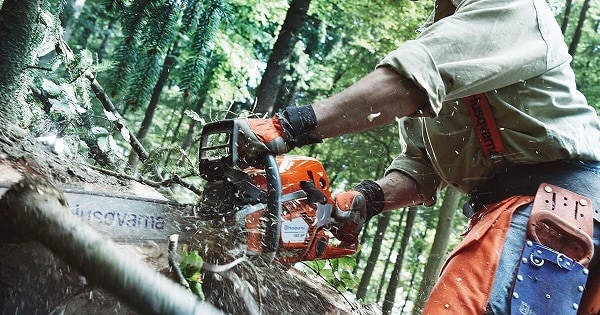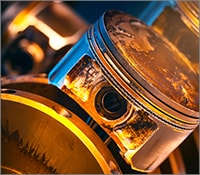
The Ins and Outs of Small Engines
How a Small Engine Works

When you peel back the equipment housing, though, you might be fascinated at what you find. For example—hundreds or even thousands of combustion explosions are happening in your engine every minute!
Those explosions are behind your engine's power. In this guide, we’ll explain how small engines work on a basic level, as well as explore the critical small engine parts that make this possible.
How Does a Combustion Engine Work?
Engines run on the explosive reaction between spark and fuel. At the heart of this combustion is fire--a living, breathing organism that requires oxygen, fuel, and spark.
- Oxygen, otherwise known as air, is crucial for fire. In fact, water puts out fire by depriving it of oxygen (this doesn’t work with grease fires because the grease will float on top of the water).
- Fuel is needed to sustain the fire. Basically, you need something to burn. For a campfire, that means wood. In small engines, you burn gasoline.
- Spark is what sets off the flame. Think of a match lighting a charcoal grill. In an engine, we use a spark plug.
Once you’ve created combustion, you need to harness it to do what you want. Build a cast iron or aluminum cylinder block around it to keep it contained. Next, unleash its energy on something productive, like rotating a lawnmower blade.
Converting Heat Energy to Mechanical Energy

It all starts with the piston. A piston is a metallic component inside the engine cylinder. The piston is connected to a crankshaft via a connecting rod. The crankshaft is located on the bottom of the engine (crankcase) and rotates the blades or wheels of the equipment you are using.
When combustion occurs in the engine, it forces the piston down the cylinder, which rotates the crankshaft, which makes your mower blades turn.
Without proper oil lubrication, none of these mechanical parts could effectively move. Many small engines use an oil slinger to lubricate the various engine parts, which reduces friction and operating temperatures. That's why it's important to regularly change your engine oil.
Important Small Engine Parts
We've gone through the science behind how a small engine works. Now check out this diagram for the most crucial parts of an engine. In this example, we're showing a 4-stroke engine.
The Engine Cycle
Now that you have a high-level understanding of how an engine works, let’s dig deeper and look at the engine cycle and piston.
The engine cycle describes the movement of the piston inside the cylinder and has four stages:
Intake
During the intake stage, air and fuel is fed into the combustion chamber at the top of the cylinder block (Remember, air and fuel are two of the three components needed for combustion).
In traditional engines, air and fuel is mixed in the right proportions by a carburetor, which is attached to the engine block. Many modern engines have replaced the carburetor with electronic injection (EFI) of fuel into the combustion chamber.
Compression
In order to maximize the power of combustion, the air/fuel mixture needs to be compressed. The tighter it’s compressed, the hotter and more explosive it gets. The piston compresses the air/fuel mixture as it moves up the engine cylinder.
Power
The power stage is when combustion occurs. At this point, the piston has compressed the air/fuel mixture and reached the top of the cylinder. All that’s needed is an electric spark, provided by the spark plug, to ignite the mixture. The explosion forces the piston down, creating the mechanical energy explained above (Pre-ignition or knocking occurs if the mixture explodes before being fully compressed and will damage the engine).
Exhaust
Just like a bonfire creates smoke, engine combustion creates exhaust that needs to be released. This happens during the exhaust stage. After the exhaust is expelled, the intake stage begins the engine cycle anew.
Keep in mind that the above four stages happen hundreds or thousands of times per minute in your small engine. Also, exactly how they happen varies depending on whether you have a 2-stroke or 4-stroke engine.
A major difference lies in the use of valves in 4-stroke engines. The camshaft (pictured above) controls the timing of intake and exhaust valves. Each valve needs to open at the precise moment of the engine cycle in order for the engine to run. The cam gear, push rod, rocker arms and valve springs are all part of the mechanism controlled by the camshaft to open and close the valves.
Horizontal vs Vertical Engines
- In a horizontal engine, the crankshaft is oriented sideways on the equipment (piston moves vertically). These engines are used primarily on chainsaws and leaf blowers.
- In a vertical engine, the crankshaft is oriented vertically on the equipment (piston moves horizontally). These engines are used primarily on
string trimmers, brush cutters, and mini-tillers.
It's important to have the engine oriented correctly for the equipment it's on. Not doing so can lead to improper lubrication and other problems.
Start Your Engines!
Now you know the basics of how a small engine works, but there's much more to learn! We have a library of educational articles to help you get to know your small engine.
